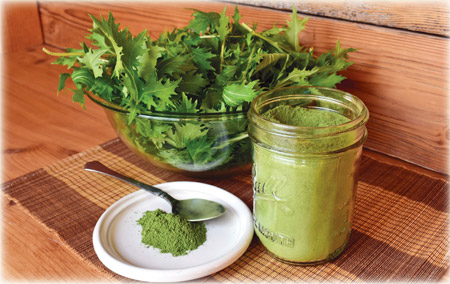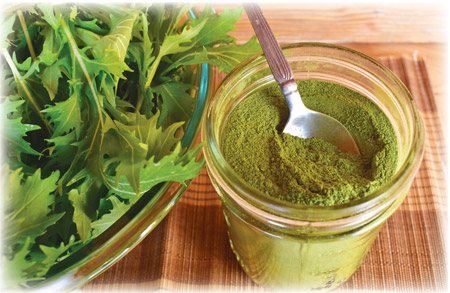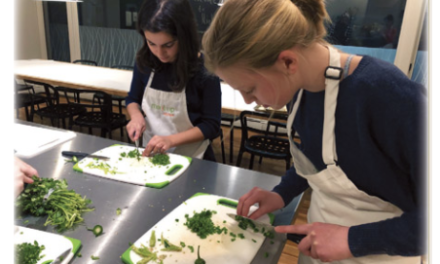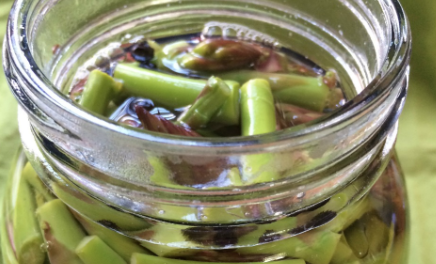Word and images by Laura Killingbeck.
It took me a while to realize that my mom was dosing all our meals with a mysterious green powder.
I had seen the green stuff sprinkled on top of bread and pasta dishes, but I’d never questioned what it was. Then one day I saw my mom reach into a cabinet, take out a mason jar of green powder, and sift it over a casserole.
“What is that?” I asked. She gave me a sly look and wiggled her eyebrows. “Vegetables,” she replied. My eyes widened. “Does Dad know?” I asked. “No,” she said. She paused. “Well, not usually.” And we both looked down at the green-dusted casserole and chuckled.

The author’s jar of “mysterious green stuff.”
Both my parents are naturalists, and my dad recently retired from a dedicated career as a botany and ecology professor at the University of Rhode Island. He’s spent decades studying, cataloging, and communing with plants. He loves them all—prickly ones, sticky ones, strange ones. It’s on those grounds that he claims a vehement dislike for eating vegetables of almost any kind. Also, he once told me he “doesn’t like the taste of chlorophyll.”
This has posed an interesting challenge for my mom, who’s spent decades of her life feeding our family. She grew up on a small farm in rural North Dakota, the second-youngest child in a pack of nine. My mom knows the value of healthy food and vegetables, and uff da, you betcha she’s not going to waste a single scrap.
Luckily, my mom’s Midwestern stoicism is matched with a crafty flair for creative problem solving. If she couldn’t get my dad to eat his vegetables intentionally, maybe there was…another way. For years now, she’s sprinkled her jar of mysterious green stuff in nearly everything she cooks. Apparently, this strategy hides not only the sight of the vegetables, but also the taste of the chlorophyll.*
I recently had dinner with my parents at their home in Rhode Island, and when we finished eating, I asked if there was any green stuff in the meal.
“Oh,” said my mom, “in the potatoes.” “Really!” I said, “I hadn’t even noticed!”
“And,” she continued, “in the cheesecake.” I did a double take and turned to my dad. “Did you know that? That it was in the cheesecake?” “Oh, I know it’s in everything,” he laughed. “I don’t mind.” There is a reason they have been married for over 40 years.
I work at Round the Bend Farm, a Center for Restorative Community, in South Dartmouth, Massachusetts. We grow an abundance of nutrient-dense, mineral-rich crops. Our Garden Manager, Benoit Azagoh-Kouadio, takes special care to douse each plant with finely crafted, biodynamic foliar sprays, soil drenches, and mineral mixes. If these plants don’t add ten years to your life just by being near them, I don’t know what will. And just like my mom, I’ll be danged if I waste a single scrap.

Power Powder made from fresh greens.
Last spring when the greenhouse had more greens than we could eat, I cut a bushel of spinach and stuffed it in the dehydrator. A few hours later, I took out the crispy leaves and ran them through a blender. I poured the powder through a sieve and looked down at my pile of green dust. This was the magical powder my mom had been making all along. And now it was here, at my fingertips.
After that first batch of spinach, I started running the dehydrator almost nonstop. I dried kale and arugula, mustard, and mizuna. When the nettles unfurled, I cut them back and popped them in too. I clipped tender mounds of chickweed and fresh sprigs of lamb’s quarters. Everything went into the dehydrator, into the blender, and out the other side as beautiful green powder. I was rich in green stuff.
Slowly, our farm lunches began to take on a distinctive green hue. I baked the green stuff into naan bread, tortillas, and cakes. I stuck it in energy bars and swirled it into cookie dough. Once, I mixed it into homemade pasta and served it to our neighbors, the actress Jenny Slate and artist Ben Shattuck. They were very gracious. Other folks at the farm dumped the powder in their smoothies and added it to granola. One day, farmer Monica Mejia said she thought the powder would make great green eggs and ham.
“You’ve tried that?” I asked, curious.
“Well, no,” she said.

Power powder can be used to make green eggs.
So, we cracked an egg, mixed in some powder, and scrambled it up. When it was done, we peered into the frying pan. There wasn’t any ham, but we certainly had green eggs.
Over time I realized that the green stuff my mom had dosed us with—and that I was now dosing the farm with—was something people call a “superfood.” I normally shy away from that kind of lingo, but in this case, I think it fully applies. When you dry and powder organic leafy greens and wild edible weeds, you get a concentrated version of all that nutrition. It stores well, it’s easy to use, and it incorporates perfectly into baked goods. It’s not just “green stuff:” I call it “Power Powder.”
The magic of “Power Powder” is that whether you love vegetables or hate vegetables, “Power Powder” is still for you! You can bake it into a cake or swirl it into a smoothie. Whether you hide it or flaunt it, it still has the same nutritional potency. If you use a little, it seems to disappear completely; add some more, and your meal transforms in both color and flavor. You can make “Power Powder” from organic greens that you buy at the farmers’ market, or from edible plants right in your yard. It’s a foodie’s intrigue, a forager’s delight, a farmer’s resource. And you can have a lot of fun dusting it over casseroles, spreading secret vegetables in plain sight.
*I’m joking—chlorophyll remains flavorful, no matter what you do to it.
Laura Killingbeck works at Round the Bend Farm in South Dartmouth, MA, and writes about ecology and adventure. She loves long journeys by foot and pedal, and frequently forages her way along multi-month treks.







